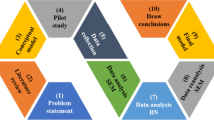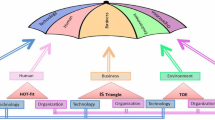Abstract
The advent of information and communication technology in healthcare sector has taken the world to a new pervasive horizon. Cloud computing is a ubiquitous way of information and data transfer. Implementation of cloud computing in daily healthcare operations can bring numerous benefits. However, there is a resistance towards the usage of this modern technology by healthcare organizations and staff due to lack of IT exposure, resources, infrastructure, patient data privacy, and security issues. Therefore, there is a need to provide an empirical evidence on how healthcare industry is responding to this new technology and to point out the factors that hinder its implementation in healthcare sector. In this paper, we aim to conduct an empirical study to investigate the behavioural intention of healthcare organizations’ staff, towards the usage of cloud-based healthcare services to carry out their daily jobs. We used unified theory of acceptance and use of technology (UTAUT) as a theoretical basis to test the predictors i.e. performance expectancy, effort expectancy, facilitating conditions, and social influence in order to find the behavioural intention of the healthcare organizations’ staff. Age, experience, and gender were also studied as moderators to investigate their effect on the behavioural intention of the user. An online questionnaire-based survey was conducted with 147 healthcare professionals in Malaysia, Pakistan, and Saudi Arabia. The results showed that social influence was the least influencing predictor in determining the dependent variable and the years of experience positively influenced user’s behavioural intentions towards using cloud-based healthcare services.



Similar content being viewed by others
References
Griebel L, Prokosch H, Köpcke F, Toddenroth D, Christoph J, Leb I, Engel I, Sedlmayr M (2015) A scoping review of cloud computing in healthcare. BMC Med Inform Decis Mak 15(17):1–16
Mellado D, Fernández-medina E (2012) A systematic review of information security governance frameworks in the cloud computing environment. J Univers Comput Sci 18(6):798–815
Inayat I, Salim SS, Kasirun ZM (2013) Agile-based software product development using cloud computing services: findings from a case study. Sci Int 25(4):1065–1069
Armbrust M, Fox A, Griffith R, Joseph AD, Katz R, Konwinski A, Lee G, Patterson D, Rabkin A, Stoica I (2010) A view of cloud computing. Commun ACM 53:4
Majhi SK, Bera P (2014) OHMF: a query based optimal healthcare medication framework. Int J Inf Process 8(3):1–12
Youssef AE (2014) A framework for secure healthcare systems based on big data analytics in mobile cloud computing environments. Int J Ambient Syst Appl 2(2):1–11
V. Koufi, F. Malamateniou, G. Vassilacopoulos, and A. Prentza, “An android-enabled mobile framework for ubiquitous access to cloud emergency medical services,” in Second Symposium on Network Cloud Computing and Applications, 2012, pp. 95–101.
Rolim CO, Koch FL, Westphall CB, Werner J, Fracalossi A, Salvador GS (2010) A cloud computing solution for patient’s data collection in health care institutions. In: 2nd International Conference on eHealth, Telemedicine and Social Medicine, pp 95–99
Nkosi MT and Mekuria SM (2010) Cloud computing for enhanced mobile health applications. In: 2nd IEEE International Conference on Cloud Computing Technology and Science, pp 629–633
Yarbrough AK, Smith TB (2007) Technology acceptance among physicians. Med Care Res Rev 64(6):650–672
Curry SJ (2007) eHealth research and healthcare delivery. Am J Prev Med 32:127–130
Atienza AA, Hesse BW, Baker TB, Abrams DB, Rimer BK, Croyle RT, Volckmann LN (2007) Critical issues in eHealth research. Am J Prev Med 32:71–74
Featherman MS, Pavlou PA (2003) Predicting e-services adoption: a perceived risk facets perspective. Int J Hum Comput Stud 59:451–474
Ramgovind S, Eloff MM, Smith E (2010) The management of security in cloud computing. In: Information Security for South Africa, pp 1–7
Lian J, Yen DC, Wang Y (2014) An exploratory study to understand the critical factors affecting the decision to adopt cloud computing in Taiwan hospital. Int J Inf Manag 34(1):28–36
Lero ML, Kieran C (2013) Factors affecting the adoption of cloud computing: an exploratory study. In: 21st European Conference on Information Systems foundation, pp 1–12
Latif R, Abbas H, Latif S, Masood A (2016) Distributed denial of service attack source detection using efficient traceback technique (ETT) in cloud-assisted healthcare environment. J Med Syst 40(7):161–173
Sajid A, Abbas H (2016) Data privacy in cloud-assisted healthcare systems: state of the art and future challenges. J Med Syst 40(6):155
Latif R, Abbas H, Assar S Distributed denial of service (DDoS) attack in cloud-assisted wireless body area networks: a systematic literature review. J Med Syst 38:128–2014
Blaya BJA, Fraser HSF, Holt B (2010) E-health technologies show promise in developing countries. Health Aff 29(2):244–251
Manuel J, Egea O, Victoria M, González R (2011) Explaining physicians’ acceptance of EHCR systems: an extension of TAM with trust and risk factors. Comput Human Behav 27:319–332
Demirkan H, Tacoma W (2013) A smart healthcare systems framework. IT Professional 5:38–45
Saleem K, Derhab A, Al-Muhtadi J, Shahzad B (2015) Human-oriented design of secure machine-to-machine communication system for e-Healthcare society. Comput. Human Behav. 51(NOVEMBER):977–985
Fleischmann R, Duhm J, Hupperts H, Brandt SA (2015) Tablet computers with mobile electronic medical records enhance clinical routine and promote bedside time: a controlled prospective crossover study. J Neurol 262:532–540
Hsieh S, Hou I, Cheng P, Tan C, Shen P, Hsu K, Hsieh S, Lai F (2010) Design and implementation of web-based mobile electronic medication administration record. J Med Syst 39:947–958
Ying A (2003) Mobile physician order entry. J Heal Informatics Manag 17:58–63
Bielli E, Carminati F, La Capra S, Lina M, Brunelli C, Tamburini M (2004) A wireless health outcomes monitoring system (WHOMS): development and field testing with cancer patients using mobile phones. BMC Med. Inform. Decis. Mak. 4(7):1–13
Sun N, Rau PP (2015) The acceptance of personal health devices among patients with chronic conditions. Int J Med Inform 84(4):288–297
Vilaplana J, Solsona F, Abella F, Filgueira R, Rius J (2013) The cloud paradigm applied to e-Health. BMC Med. Inform. Decis. Mak. 13(35):1–10
Derenzi B, Borriello G, Jackson J, Kumar VS, Parikh TS, Virk P, Lesh N (2011) Mobile phone tools for field-based health care workers in low-income countries. Mt Sinai J Med 78:406–418
Braun R, Catalani C, Wimbush J, Israelski D (2013) Community health workers and mobile technology: a systematic review of the literature. PLoS One 8(6):4–9
Chen I-J, Yang K-F, Tang F-I, Yu S (2008) Applying the technology acceptance model to explore public health nurses’ intentions towards web-based learning: a cross-sectional questionnaire survey. Int J Nurs Stud 45(6):869–878
Sedem AA, Panford JK (2015) Cloud computing framework for e-Health in Ghana: adoption issues and strategies: case study of Ghana health service. 118(17):13–17
Inkelman WAJW, Eonard KEJL, Ossos PEGR (2005) Patient-perceived usefulness of online electronic medical records: employing grounded theory in the development of information and communication technologies for use by patients living with chronic illness. J Am Med Informatics Assoc 12(3):306–314
Ierdon STP, Eitz DED, Uck SAK, Rtiz EDO (2004) Patient experiences and attitudes about access to a patient electronic health care record and linked web messaging. J. Am. Med. Informatics Assoc. 11(6):505–513
Wilson EV, Lankton NK (2004) Modeling patients’ acceptance of provider-delivered e-health. J. Am. Med. Informatics Assoc. 11(4):241–248
Ahlan AR, Isma’eel BA (2014) User acceptance of health information technology (HIT) in developing countries: a conceptual model. Procedia Technol 16:1287–1296
Sezgin E, Özkan S (2014) A literature review on attitudes of health professionals towards health information systems: from e-Health to m-Health. Procedia Technol. 16:1317–1326
Davis FD (1989) Perceived usefulness, perceived ease of use, and user acceptance of information technology. MIS Q 13(3):319–340
Venkatesh V, Davis FD (2000) A theoretical extension of the technology acceptance model: four longitudinal field studies. Manag Sci 46(2):186–2014
Venkatesh V, Bala H (2008) Technology acceptance model 3 and a research agenda on interventions. Decis Sci 39(2):273–315
Chau PYK, Hu PJ (2002) Investigating healthcare professionals’ decisions to accept telemedicine technology: an empirical test of competing theories. Inf Manag 39:297–311
Venkatesh V, Morris MG, Davis GB, Davis FD (2003) User acceptance of information technology: toward a unified view. MIS Q 27(3):425–478
Im I, Hong S, Soo M (2011) Information & Management an international comparison of technology adoption testing the UTAUT model §. Inf Manag 48:1–8
Creswell JW (2009) Research design: Qualitative, quantitative, and mixed methods approaches, 3rd ed. Sage Publications Inc, Thousand Oaks, California
Vogt WP (2009) Quantitative research methods for professionals. Pearson Education, Boston, MA, US
Chow M, Herold DK, Cho T-M, Chan K (2012) Extending the technology acceptance model to explore the intention to use second life for enhancing healthcare education. Comput Educ 59(4):1136–1144
Egea JMO, González MVR (2011) Explaining physicians’ acceptance of EHCR systems: an extension of TAM with trust and risk factors. Comput. Human Behav. 27:319–332
Moores TT (2012) Towards an integrated model of IT acceptance in healthcare. Decis Support Syst 53:507–516
Pai F-Y, Huang K-I (2011) Applying the technology acceptance model to the introduction of healthcare information systems. Technol Forecast Soc Chang 78:650–660
Wu I-L, Li J-Y, Fu C-F (2011) The adoption of mobile healthcare by hospital’s professionals: an investigative perspective. Decis Support Syst 51:587–596
Zhang H, Cocosila M, Archer N (2010) Factors of adoption of mobile information technology by homecare nurses. Comput Informatics, Nurs 28(1):49–56
Kowitlawakul Y (2011) The technology acceptance model: predicting nurses’ intention to use telemedicine technology (eICU). 29(7), 411-418. Comput. Informatics, Nurs. 29(7):411–418
Carayon P, Cartmill R, Blosky MA, Brown R, Hackenberg M, Hoonakker P, Walker JM (2013) ICU nurses’ acceptance of electronic health records. J. Am. Med. Informatics Assoc. 18:812–819
Groves RM, Fowler FJ, Couper MP, Lepkowski JM, Singer E, and Tourangeau R (2009) Survey Methodology, 2nd ed. Wiley, p 488
Cronbach L (1949) Essentials of psychological testing. Harper & Row, New York, p 726
Cronbach L (1951) Coefficient alpha and the internal structure of tests. Psychometrika 16:297–334
Raykov T (1997) Estimation of composite reliability for congeneric measures. Appl Psychol Meas 21(2):173–184
Sykes AO (2007) An introduction to regression analysis. Am Stat 61:1–33
Straub DW (1989) Validating instruments in MIS research. MIS Q 13(2):147–169
Hair JF, Tatham RE, Anderson RL, Black W (1998) Multivariate data analysis Englewood Cliffs: Prentice Hall, 5th edn. Prentice Hall, Englewood Cliffs
Field A (2009) Discovering statistics using SPSS, 3rd edn. SAGE Publications Inc., Thousand Oaks, California
Acknowledgements
This Project was funded by the National plan of Science, Technology and Innovation (MAARIFAH), King Abdulaziz City for Science and Technology, Kingdom of Saudi Arabia, Award Number (12-INF2817-02).
Author information
Authors and Affiliations
Corresponding author
Appendix A
Appendix A
Questionnaire.

Rights and permissions
About this article
Cite this article
Amin, R.u., Inayat, I., Shahzad, B. et al. An empirical study on acceptance of secure healthcare service in Malaysia, Pakistan, and Saudi Arabia: a mobile cloud computing perspective. Ann. Telecommun. 72, 253–264 (2017). https://doi.org/10.1007/s12243-016-0553-4
Received:
Accepted:
Published:
Issue Date:
DOI: https://doi.org/10.1007/s12243-016-0553-4




